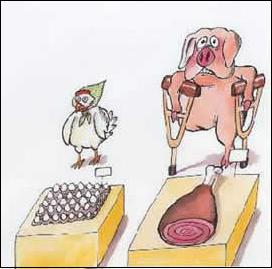Are Your Characters Chickens or Pigs?
 In a breakfast of ham and eggs, what’s the difference between a chicken and pig? The chicken is involved. The pig is committed.
In a breakfast of ham and eggs, what’s the difference between a chicken and pig? The chicken is involved. The pig is committed.
I named this blog Hard Lessons for a reason. The rules of writing aren’t always obvious. I started writing decades back as a hobby. I shared my stories and essays with friends and they seemed to enjoy my work. Life was good as long as the characters were properly heroic, had some interesting character traits, and spun witty dialog.
Or so I thought.
I began studying the craft and inviting professionals to critique my work. Two of the many issues discovered were sagging plots and short scenes. The stories were enjoyable enough but I my readers never finished the longer ones. The reason? Lack of tension.
Conflict is the essential interest-inducing, ingredient in stories. It creates doubts as to the outcome leading your readers to turn the next page. It comes in many forms, most of which we learned in high school. Is the following list familiar?
- Man vs. Man/Society
- Man vs. Nature
- Man vs. Self
A previous post detailed scene/sequence combinations – the pattern of conflict followed by introspection. This post will focus on Scenes and the importance goals, conflict, and setbacks.
Scenes
The elements of a scene are point-of-view (PoV), goal, conflict, and setback.
The Main Character (MC) has a goal and something stands in the way. The reader should know the goal early on. Back to Pig vs. Chicken – is your character committed to the goal or just involved in achieving it. If the MC isn’t committed to the goal your PoV is wrong. Find another that really cares about the outcome. By default, the PoV of the scene should be the person with the most to lose i.e. committed.
What about the goal of the antagonist? How committed are they to the goal: Pig or Chicken? The need to be Pigs. Great villains invest themselves in victory. Think of Darth Vader. He wants to bring order to the Galaxy and believes in that cause. The Storm Trooper in the same scene is just following orders.
After you know the goal, describe the conflict. Don’t spare the paragraphs. Build the tension over pages. Use stimulus/response. The Antagonist does something. The Protagonist responds. Back and forth until the scene is over. Keep saying to yourself at each turn, Chicken or Pig?
Now, is there a setback? Did the MCs accomplish their goals? Your answers are
- Yes
- Yes, but
- No
- No and further more
See the previous post describing each of the above. Your answer needs to be one of the latter three.
So what’s the difference between your Antagonist and Protagonist? The Antagonist gets more Yes answers. Things break in the direction of the tension builder. That said, don’t make it too easy on you villains. Make them work for it as well. Remember, they need to be pigs.
So how does this play out? In my upcoming novella, there was a scene where the captain piloted a shuttle avoiding certain doom. The story was written in first person so I’m stuck with the guy sitting next to the pilot. Originally, he watched and described the action. He was a chicken, involved but not committed. The pilot was committed. So how to fix it.
Get the PoV involved and at the center of the action. Don’t let other characters lead the way. It seemed awkward at first but in the end gave at much better product. Remember that the reader sees things from the PoV. Give them an adventure!